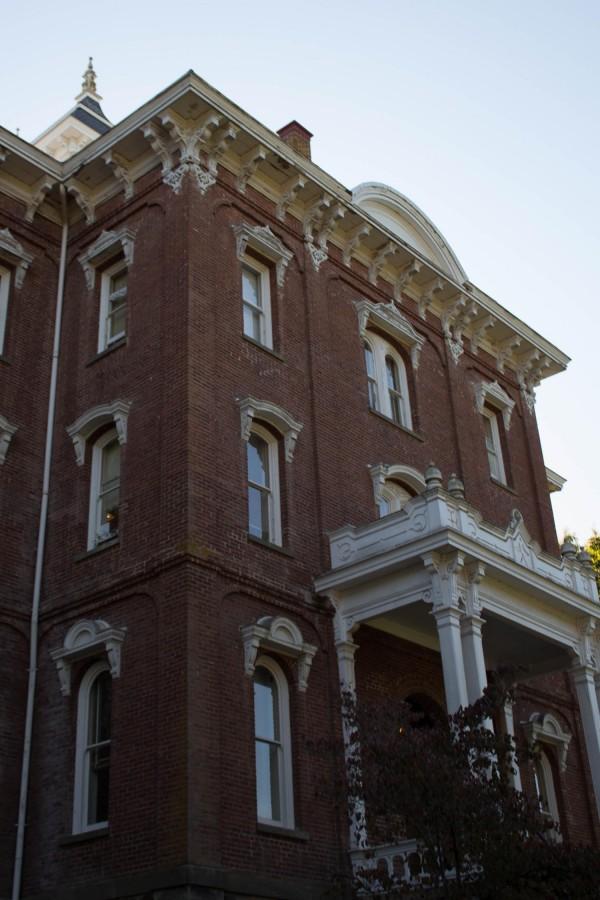The first week of March marked the 25th anniversary firing of the kiln, a 30-foot furnace built into a hill near Professor of Art and Visual Culture Nils Lou’s studio in Willamina. While the kiln is fired about six times per year, this celebratory firing attracted twice the usual crowd of potters, ceramic professors and students and was what Lou calls, “one of the best firings we’ve ever had.”
It’s midnight. Blackness blankets the forests of Willamina,Ore., and the only surroundings glimpsed in the near-useless headlights are a few feet of uneven dirt road and countless trees. Just when you feel like you’re going to pop out in a J.R.R. Tolkien novel, you reach the clearing, where what appears to be a colossal hobbit home emerges from the side of a hill. But before you see Bilbo, a chorus of voices welcome you to the East Creek Anagama Kiln.
Cave Kiln
Since Nils Lou, professor of art and visual culture, and two of his potter friends built the kiln in 1985, it has been fired 105 times. Used as a learning tool for ceramics students and a resource for Northwest potters, the kiln has lasted longer than Lou expected.
“I think it’s almost like any relationship, whether it’s with another person or anything that we personalize,” Lou said. “We assign it a certain vitality and life, and it takes on a form sometimes that goes beyond what we think it might.”
The kiln is based on an eighth-century Korean anagama, Japanese for “cave kiln.” And the translation fits because these kilns, or caves for pots, are built into the sides of hills.
Brittney Bailey, class of ’09, whose parents know Lou, has been involved with the kiln since a young age and said the East Creek Anagama is the oldest in the area.
“When this kiln was built, it was the only anagama style of kiln of its kind on this side of the Mississippi,” she said.
The anagama design emerged in Japanese, Chinese and Korean cultures nearly 2,000 years ago. It consists of one long chamber with a fire box in the front and a flue in the back.
The kiln’s sides are also pierced by small ports used to drop in fuel. East Creek Anagama is a traditional wood kiln, so it uses wood to fuel the firing process as opposed to the gas- and electricity-powered kilns of the modern age.
Pots placed into the kiln aren’t glazed like those for electric kilns, either. Instead, the burning wood’s ash serves as paint for the pots.
“The ash itself is in many cases allowed to settle on the wear, the pottery,” Lou said. “The heat is enough to melt that ash into runny glazes.”
And it’s hot indeed. Lou said temperatures along the kiln reach between 2,300 and 2,500 degrees, enough to melt the ash and vitrify the clay — that is, make it glassy.
The process of preparing, loading, firing and cooling the kiln takes about three weeks, Lou said.
A fire is started in the main fire box, and it heats up gradually so that, after 10 to 12 hours, the fire can move back along the kiln. The heat rises, baking pots placed on shelving above the fire.
“There’s a river of flame and ash that can move freely through the pots,” Lou said.
When the firing is complete, usually after two to four days, the kiln is closed, sealed and cooled for an entire week.
“If you open it up too early, the pieces go through a sort of a shock from entering an atmosphere that’s much colder than the one they were in before, and they’ll crack,” Bailey said.
Because the ash flow in the kiln is uncontrollable, how the pots look when they come out is a mystery.
“Part of the process is to learn how to not anticipate too powerfully what to expect,” Lou said. “You learn to accept what comes and to appreciate all of the iterations of fire and ash and things that have happened to it that are actually somewhat beyond our control.”
Burning the midnight oil
Next to the blazing kiln, Linfield students and a few others sat in light jackets or T-shirts, waiting for the call to stoke the fire. But shouts of “Stoke!” and the roaring of the kiln weren’t the only sounds. People were telling stories, chatting about the future and, on the night of March 5, belting out Violent Femmes and Tom Petty tunes accompanied to the guitar strumming of senior Duncan Reid.
And when the fire flared up through the ports, the students gasp. As Reid put it, “You’ve angered the dragon.”
Lou requires his ceramics and sculpture students to visit the kiln.
“It’s not designed to make wood fire potters out of people who aren’t but merely to introduce them to this kind of unique and fun way of doing this,” he said. “It’s not a one-person operation; it is a community. I think there is some energy there that is very exciting and interesting to experience.”
Junior Gabe Stallings, a ceramics sculpture major, has been taking classes from Lou throughout his time at Linfield. This was his third year at the firing.
“For me, this is an opportunity to let the ‘Kiln Gods’ decide what will happen to the piece I put in the kiln,” he said in an e-mail. “I surrender all control over what will happen and just hope that it comes out interesting or beautiful in some way.”
This year, Stallings said he helped chop wood and stoke the fire.
Freshman Tyler Gerlach also helped stoke the fire from 10 p.m.-2 a.m. March 5. But unlike Stallings, Gerlach isn’t a ceramics student. He said his girlfriend, a student of Lou’s, brought him along.
“I had no idea what the experience was going to be like because I had no idea where we were going when I was in the car,” Gerlach said in an e-mail.
For him, the sense of community at the firing made the night worthwhile.
“I found out some things about myself, such as how much community gatherings really mean to me,” Gerlach said in an e-mail.
Linfield students weren’t the only ones helping at the kiln. Students from George Fox University and Lakeridge High School in Lake Oswego, Ore., also had pieces in the kiln and came out to the firing.
Two Lakeridge students, sophomore Lindsay McCord and senior Tolley Rippon, said it was their first time at the East Creek Anagama, but they have been to other kiln firings.
“It gave me some new ideas,” McCord said.
Rippon said he was sleeping overnight in the studio on the property. Many other students and visitors were staying in a cabin or bunkhouse adjacent to the kiln.
The event attracted graduates, too. Besides alumna Brittney Bailey, class of ’09, James Duckworth, class of ’07, also showed up — all the way from Montana.
“I came for the free food,” he laughed, referring to a potluck that took place earlier that night.
The firing was also a celebration of Lou and what he’s done for the area during the past 25 years, Duckworth said.
When in school, Bailey said the firing was a chance for students to leave the hectic atmosphere of school and enjoy a peaceful time with friends.
Duckworth agreed, but the first time he went to the kiln, he was a bit unsure.
“I was, like, ‘Where the hell are we going?’” he said. “But now, it’s like a reunion every time.”
Although Bailey has been helping with the kiln all her life, she said she seldom makes pieces to put in the kiln.
“For me, it’s a lot more the family-friends aspect than the actual production of pots since I rarely put anything in the kiln,” Bailey said. “It’s a shaping element in my life [because] I’ve been doing it since birth.”
Overall, the two alumni agreed that the East Creek firings present an opportunity for potters, students and friends to unite, learn and have a good time.
“Potters are not necessarily part of the tortured artist group; they’re generally fairly happy, pretty quirky,” Bailey said. “They want to have fun, and for as dorky and, like, as fringe members of society that they are, they get here, and they feel comfortable, and they’re with their people. And there’s just kind of that glee that comes with being with people that get you.”
Unfolding drama
The kiln site brimmed with excitement as ceramic professors, potters, students and even neighbors huddled around the anagama’s opening, each trying to catch a glimpse of the treasures inside. Surprised “ooos” and “aahhs” filled the air, along with shouts of “Happy 25th anniversary” and “I’ll start the bidding on that one!” There were even some “uh-ohs” at pieces that came out cracked, fused together or shattered.
“It’s an unfolding drama,” Lou said.
Despite a few broken pieces, Lou said this was one of the best firings yet, and everyone was pleased with the colors and effects the kiln delivered.
Jason Laney, a potter who teaches at the Woodburn Art Center and the Silverton Art Association, had a few pieces in the kiln. This was his second time to the East Creek Anagama, he said.
“It’s just a lot of fun getting together with everybody and playing with fire,” Laney said. “You really get to pick each other’s brains.”
J. Lee, who moved into the property next to Lou about two months ago, wandered down to see the results of the firings. Lee is a painter and said the risk and unpredictability of wood firing warded her away from ceramics. But she said that this event almost made her want to be a potter.
“I’m just amazed at what’s here,” she said. “It’s really thrilling to move into a cabin in the woods and find all this art.”
View more photos of the kiln’s 25th anniversay firing here.
Kelley Hungerford
Managing editor Kelley Hungerford can be reached at [email protected]



Thom Caccamo • Mar 29, 2011 at 9:23 am
how would I get in touch with Nils Lou to find out about participating in a future firing? thank you Thom Caccamo